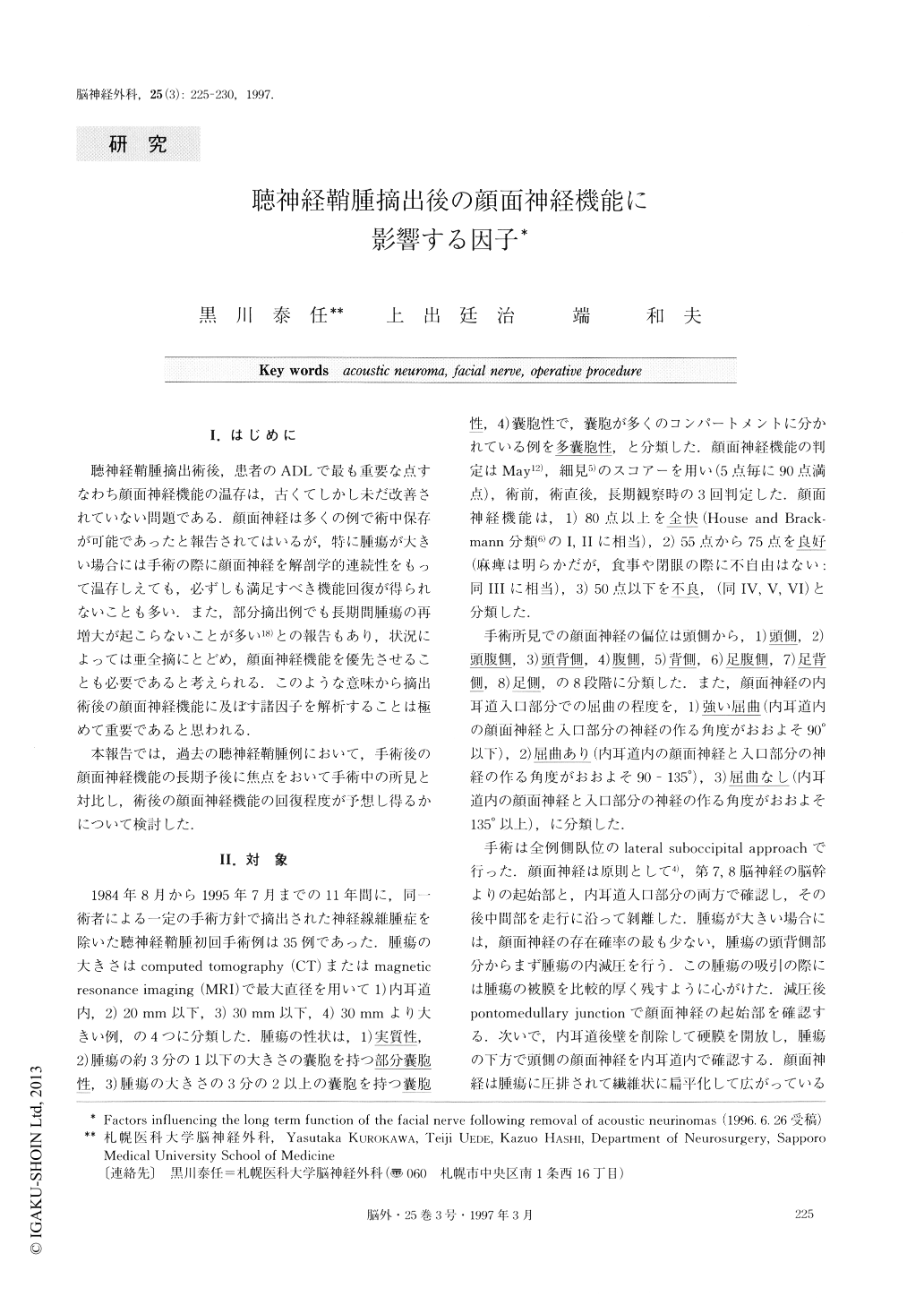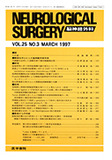Japanese
English
- 有料閲覧
- Abstract 文献概要
- 1ページ目 Look Inside
I.はじめに
聴神経鞘腫摘出術後,患者のADLで最も重要な点すなわち顔面神経機能の温存は,古くてしかし未だ改善されていない問題である.顔面神経は多くの例で術中保存が可能であったと報告されてはいるが,特に腫瘍が大きい場合には手術の際に顔面神経を解剖学的連続性をもって温存しえても,必ずしも満足すべき機能回復が得られないことも多い.また,部分摘出例でも長期間腫瘍の再増大が起こらないことが多い18)との報告もあり,状況によっては亜全摘にとどめ,顔面神経機能を優先させることも必要であると考えられる.このような意味から摘出術後の顔面神経機能に及ぼす諸因子を解析することは極めて重要であると思われる.
本報告では,過去の聴神経鞘腫例において,手術後の顔面神経機能の長期予後に焦点をおいて手術中の所見と対比し,術後の顔面神経機能の回復程度が予想し得るかについて検討した.
Thirty-five cases with removal of acoustic neurino-mas were reviewed to demonstrate the factors which influenced the postoperative long term function of the facial nerve. All cases were operated on via a subocci-pital route. The group consisted of 7 cases with the tumor confined to the internal auditory meatus, 4 cases with a neurinoma of 20 mm or less in diameter, 13 cases with a neurinoma of 30 mm or less, and 11 cases with a neurinoma over 30 mm. The consistency of the tumors was solid in 27 cases, and cystic in 8 cases. Dis-location of the facial nerve was observed during the op-eration except in 7 intrameatal cases. The dislocation is summarized as follows: dislocated in the cranial direc-tion in 2 cases, ventrocranial in 7, ventral in 5, ventro-caudal in 10, dorsocaudal in one, and caudal in 3 cases.No case showed dislocation of the facial nerve in the dorsocranial or dorsal direction. Careful observation of the facial nerve at the entrance of the internal auditory meatus showed a severe kinking in 2 cases, moderate kinking in 2, but no kinking at all in the remaining 31 cases. The facial nerve was preserved anatomically in all cases. Long term function of the facial nerve can be summarized as excellent in 18 cases, good in 8 cases, and poor in 9 cases. Three cases showed an almost complete paresis of the facial nerve immediately after the operation and recovery was never observed. Neurinoma facial score was defined in 28 cases, ex-cept intrameatal cases, according to the degree of preoperative facial nerve function, tumor size, presence of the cystic component within the tumor, direction of the facial nerve dislocation, and the presence of kinking of the facial nerve. The correlation between the long term facial nerve function and the neurinoma facial score was statistically examined and was found to be significant (Sperman's correlation coefficient by ranks; rs=0.38596>0.375; P=0.05).
In conclusion, neurinoma cases that show the least facial nerve function are: cases in which facial function had deteriorated, cases in which the tumor was large or when the tumor had no cyst, when dislocation of the facial nerve was in the cranial direction, and in cases where there was kinking of the facial nerve at the in-ternal auditory meatus. In such cases, the removal should be carried out intracapsularly so as to preserve facial nerve bundle which may spread and become flat-tened like a tumor capsule. This might minimize the postoperative deterioration of the facial nerve function.

Copyright © 1997, Igaku-Shoin Ltd. All rights reserved.


